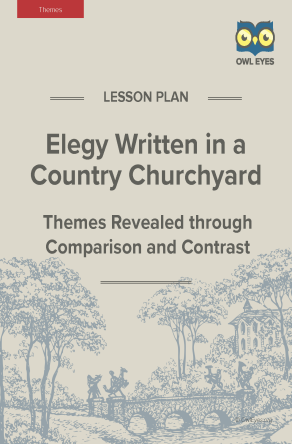Elegy Written in a Country Churchyard Themes Lesson Plan
- 23 pages
- Subject: Historical Context, Imagery, Literary Devices, Themes, Lesson Plans and Educational Resources
- Common Core Standards: RL.11-12.1, RL.11-12.2, RL.11-12.3
- Grade Levels: 10, 11, 12
Additional Elegy Written in a Country Churchyard Resources
Product Description
Themes Revealed through Comparison and Contrast in “Elegy Written in a Country Churchyard”
This lesson plan focuses on Gray’s use of contrast in developing several major themes in the poem. Students will identify and examine how Gray describes the villagers before and after their deaths and how their simple lives contrast with those of the wealthy and powerful. Students will analyze the speaker’s perspective on death and memory by studying specific passages, namely descriptions of the headstones, perceptions of the villagers’ lives, and references to famous people from English history. By analyzing contrasting elements in the text, students will be better able to identify themes in the poem and explain how the text develops to further these themes.
Skills: close reading, contrasting, drawing inferences from the text
Learning Objectives: By the end of this lesson, students will be able to
- identify the characteristics of an elegy found in the poem
- explain how the villagers are described in life and in death, noting the contrasts
- analyze and describe how the villagers differ from those who possess wealth and power
- determine how Gray presents death as a universal human experience, regardless of social class
- identify major themes in the poem and explain how they are developed through comparison and contrast in the text
About This Document
Owl Eyes lesson plans have been developed to meet the demanding needs of today’s educational environment and bridge the gap between online learning and in-class instruction. The main components of each plan include the following:
- An introduction to the text
- A step-by-step guide to lesson procedure
- Previous and following lesson synopses for preparation and extension ideas
- A collection of handouts complete with answer keys
Each of these comprehensive, 60-minute plans focus on promoting meaningful interaction, analytical skills, and student-centered activities, drawing from the Common Core Standards for English Language Arts and the expertise of classroom teachers.
Introduction to the Lesson
One of the best-loved and most-often quoted poems in English literature, “Elegy Written in a Country Churchyard” established Thomas Gray as a major poet among his literary peers.
Thomas Gray’s life was fraught with conflicts and personal tragedies; they, as well as a perhaps obsessive perfectionism regarding his writing, resulted in his producing a limited body of poetry. The poems he did publish, however, are regarded as premier works in 18th-century English literature, with none more celebrated than “Elegy in a Country Churchyard.”
Published in 1751 as “An Elegy Wrote in a Country Church Yard,” Gray’s signature work is a sophisticated meditation on the nature of death. While the poem’s narrator explores his personal thoughts about death and memory, the elegy’s themes are universal. Written in the structure and style of 18th-century neoclassic poetry, the elegy features elements that anticipate the rise of romanticism in English literature. It focuses on the individual life, the elevation of the common man, and the depiction of the natural world as a source of beauty and peace.
Gray’s elegy opens with his famous description of the English countryside at twilight, meditating on lowing herds, tolling bells, and slow, plodding motions of workers returning home.: “The curfew tolls the knell of parting day. / The lowing herd winds slowly o’er the lea. / The plowman homeward plods his weary way. / And leaves the world to darkness and to me.” As shadows fall and the moon rises, Gray directs readers’ attention to the graves in the cemetery near the village church. The poem’s dynamic meditation on death begins with a description of the lives of those buried in the churchyard and ends with the speaker describing his own death as he imagines it. The somber, meditative tone of the poem adds to the dreamy, pensive tone of the poem. The speaker moves from specific thoughts about his own mortality to general ideas about the nature of death and back again to contemplate death as both a personal and universal experience.
Worksheet Excerpt—Interpreting the Text: Stanzas 4–8
-
Briefly summarize what is said in your stanzas. What are the main ideas that the speaker covers?
-
How are the graves of the villagers described in stanzas 4–5?
-
In stanzas 5–7, how does Gray describe the villagers as they once lived?
-
In stanza 8, what does the personification of ambition and grandeur suggest? How do the lives of the villagers contrast with “Ambition” and “Grandeur”?
-
Based on these observations, how do the poor and the rich differ after death?
-
What does this tell you about the speaker’s perception of death and the theme of the story?







